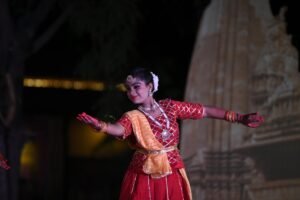No products in the cart.
A Celebration of Culture and Tradition
Through the Traditional Folk Dances of Madhya Pradesh - Khajuraho Dance Festival
Madhya Pradesh, the heart of India, has a rich cultural heritage, beautifully reflected in its diverse folk dances. These dances, deeply rooted in tradition, serve as an artistic expression of faith, joy, and social harmony. Whether performed as a tribute to deities or as a means of celebration, each dance narrates a unique story of the region’s history and people. From the vigorous rhythms of Bundelkhand to the graceful swirls of Malwa, the folk dances paint a vivid picture of the region’s cultural richness.
Here is a list of famous traditional folk dances of Madhya Pradesh
Tribal Dances: A Reflection of Nature
The tribal dances of Madhya Pradesh are deeply inspired by nature, mimicking the swaying of trees, the movements of animals, and the harmony of life in the forests. These dances are performed in circular formations, symbolizing the spherical shape of the Earth and unity with nature. Unlike folk dances, which have designated performers, tribal dances encourage participation from all community members, making them a collective celebration of life.
The tribal communities of Madhya Pradesh have a deep-rooted connection with their land. The Bharia tribe’s Ahirai dance, performed in rhythmic circles to the beats of drums and timki, often continues through the night. Influenced by the environment, the music and instruments vary across regions – dense forest communities rely on percussion for long-distance resonance, while hilly and plains regions incorporate wind and string instruments, reflecting their distinct landscapes. These dances are not mere performances but expressions of community life, marking occasions from harvests to weddings, and from festivals to childbirth.
Rai: The Dancing Spirit of Bundelkhand
This unique dance form that originated in Bundelkhand is named after the swirling movement of mustard seeds or rai. Historically, the dance was performed to mark the celebration of bountiful harvests, royal victories, and wedding festivities.
The dance is particularly known for its graceful movements, where performers – traditionally women from the Bedia tribe – wear lehengas spanning up to seventeen yards. As they twirl, the semicircular formation resembles a peacock’s spread wings, creating a stunning visual spectacle.

The performance builds gradually, starting with the Dadra rhythm accompanied by traditional percussion instruments like nagada, dholak, jhika, and ramtula. The most unique feature of Rai dance is the dynamic interaction between dancers and drummers, who perform acrobatic moves, including the distinctive ‘scorpion’ pose – walking on hands with upturned feet. Dressed in vibrant colours with traditional jewellery, the dancers keep their faces veiled. The male musicians, donning traditional Bundelkhandi turbans and dhotis, complement the performance with folk tunes.
Naurata: A Ritualistic Dance of Bundelkhand
Naurata dance is performed during Navratri to invoke blessings for unmarried girls to get a good match and enjoy marital bliss. On this occasion, intricate designs are painted using lime and natural colours outside homes.
Badhai Dance: A Celebration of Life
Badhai dance is an expression of joy and is performed during auspicious occasions like births, weddings, and festivals in the Bundelkhand region. The performers coordinate their vigorous movements with upbeat music, creating a captivating sight.
Other notable dances of Bundelkhand include Saira, where young performers with sticks move to melodies themed on Lord Krishan, and Jawara, in which women gracefully balance crop baskets, celebrating agricultural prosperity. Kanara and Dhirmarthai are unique community dance traditions, while Diwari, performed during Diwali, showcases Krishna’s legends through martial movements and peacock-adorned performers.
Dancing Tales of Baghelkhand: Where Tradition Meets Expression
In the Baghelkhand region, folk dances in the Bagheli dialect tell stories of love, tradition, and community spirit. The Ahirai or Birha dance uniquely combines matchmaking with artistry, where young men and women dance to the sounds of nagadiya and shehnai, often leading to lifelong partnerships.
The graceful Kalsa dance sees performers balance urns on their heads to welcome guests with question-answer-styled movements. Meanwhile, the inclusive spirit of the region shines through dances like Dadar and Kemali, where entire communities come together in celebration.
Perhaps, the most spectacular is the Atari, performed by Bhumiya and Baiga tribes, where dancers create human pyramids, dancing atop each other’s shoulders in circular formations. Each dance form – from the rhythmic Kehra to the marriage-celebrating Kemali – weaves together Baghelkhand’s rich cultural tapestry.
Matki: Malwa’s Graceful Traditions
The Matki dance of Malwa is a vibrant celebration of joy, skill, and tradition. Named after a matki or water pot, it features women gracefully balancing pots while performing intricate circular movements in vibrant attire. It begins with a solo woman performer, later joined by a group of women dancers, who groove to rhythmic drum beats, with their decorated matki becoming both prop and symbol. This traditional dance perfectly captures Malwa’s cultural spirit through its unique blend of skill, grace, and celebration.
Gangaur: A Devotional Dance
Performed during the nine-day Gangaur festival, this dance is an act of devotion towards the deities Ranubai and Dhaniyer Suryadev. Particularly popular in the Nimar region, the dance is intertwined with rituals and musical sequences.
Bhagoria: The Dance of Love and Courtship
The Baiga community celebrates Bhagoria dance, especially during the Dussehra festival. It is intertwined with a unique custom where young women welcome eligible bachelors from neighbouring villages with song and dance. This dance is a vibrant expression of the community’s cultural identity and social traditions.
Modern Celebrations
The folk dances of Madhya Pradesh are a living, breathing testament to the state’s cultural richness. Even the attire of the performers is influenced by their surroundings, featuring elements like feathers, shells, and leather that symbolise their relationship with nature.
Today, festivals like the ‘Khajuraho Dance Festival‘, ‘Lokrang‘ and the Akhil Bhartiya Kalidas Samaroh keep these traditions alive, providing platforms for folk and tribal dancers to showcase their art. These celebrations ensure that the rich dance heritage of Madhya Pradesh continues to enchant and inspire new generations.




















